
Anna Dugina, an expert gemologist of the combine.
Pavel KuzmichevMany people in the world highly value amber. In Russia, almost every woman has jewelry with amber. Russians love amber not just for its unbelievable beauty and availability (it’s much cheaper than diamonds and emeralds); it’s believed that it also possesses healing qualities.

Jewelry from Kaliningrad Amber Combine.
Pavel KuzmichevAccording to different data, from 80% to 95% of the world’s supply of this gem is concentrated in Russia. There are deposits in Sakhalin and Taymyr, but the largest one is situated in the small village of Yantarny in Kaliningrad Region. Scientists have conducted some calculations: Each cubic meter of amber-bearing rock – ‘the blue earth’ – contains 1.9 kilograms of amber.

The only enterprise in the world that engages in the industrial production of amber is the ‘Kaliningrad Amber Combine’ (part of the ‘Rostec Corporation’).
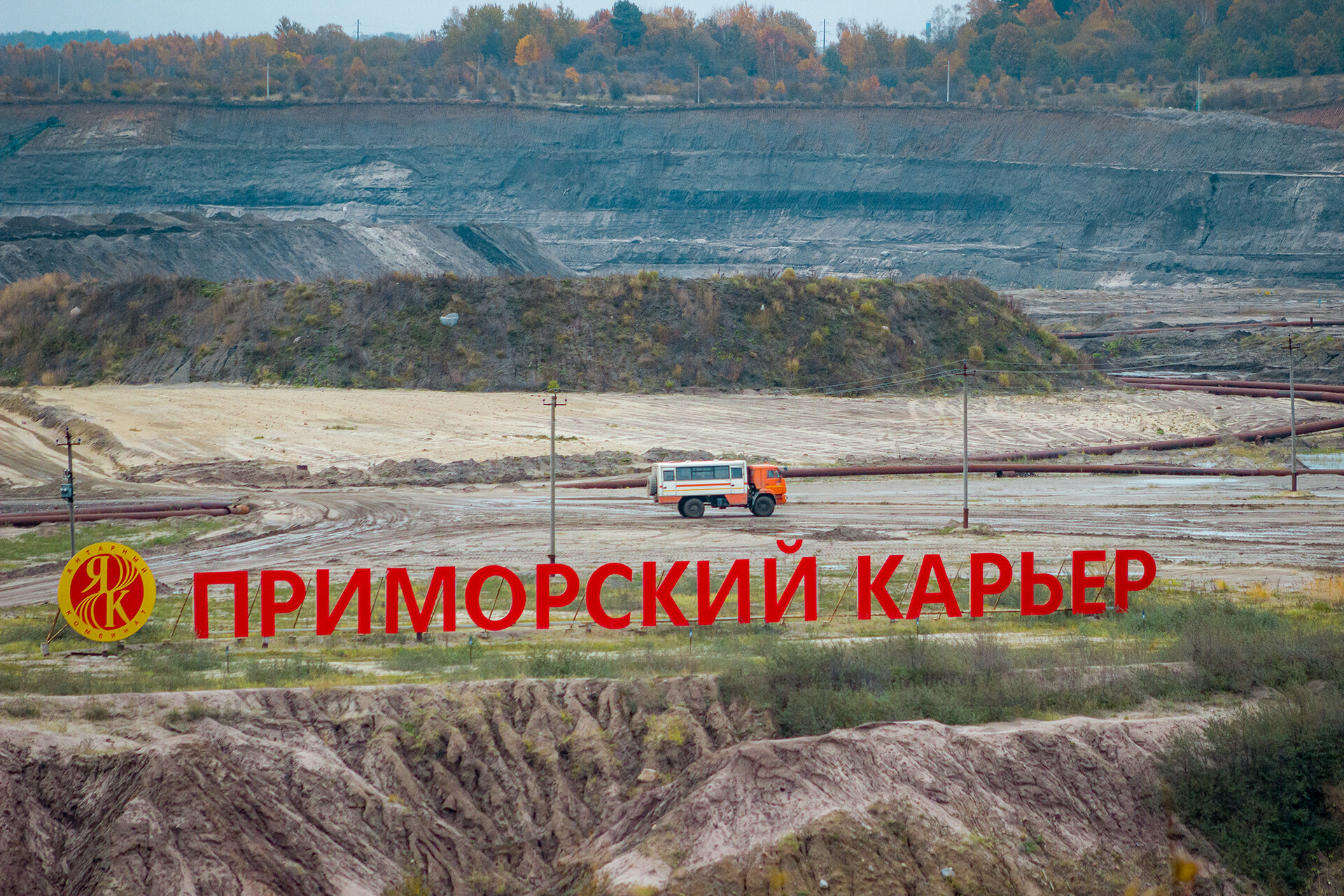
Currently, they’re developing the Primorsky quarry, which we managed to visit.
You can’t simply see amber, it’s contained in ‘blue earth’ (it really does have a blue hue), at a depth of 50-60 meters.

This is what the amber mining site looks like.
Pavel KuzmichevThe process of extraction itself looks quite unusual: A worker stands at the bottom of the quarry with a water system and strikes the amber-bearing rock with a jet of sea water.

“You can’t wash it out with regular water, the rock is very dense,” Alexey Korkin, leading geologist of the quarry, explains to us. “So we use water from the Baltic Sea. To wash out one cubic meter of this clay, we need eight cubic meters of such water.”

There's tons of amber here, but you can't see it.
Pavel KuzmichevThis way, we now have pulp – a mix of ‘blue earth’ and sea water – which flows down along the channel into a special ditch, from where it’s transported through a pipe to an enrichment plant.

Due to the fact that water is needed in the process, amber can only be extracted in positive temperatures, when the water is not yet frozen. Usually, extraction lasts until the middle of November; in winter, meanwhile, the quarry undergoes maintenance.

The largest amber stones are manually examined at the processing plant.
Pavel KuzmichevIn one workday, the quarry produces 3 to 5 tons of amber. Among them, nuggets weighing more than 1 kilogram are sometimes found. They are usually picked out at the plant, since initially they’re covered with a layer of clay. It’s hard to believe that tons of amber are rolling past us right now! “Over this season, we have already extracted 12 nuggets,” Alexey says. “The heaviest of them was found back at the beginning of spring, it weighed 1.876 kilograms!”

Nuggets at the combine museum.
Pavel KuzmichevUntil recently, large specimens were being caught with nets, but now, machinery tackles this task just as well.
The quarry has been in operation since 1976 and estimates say the supply will last for at least another hundred years. The annual yield is 500-600 tons, with the deposit reserves currently at 53,000 tons.

This dragline is helping to reclaim quarry land.
Pavel KuzmichevAll excess rock is removed with the help of a dragline – a walking excavator. There are three at the quarry. And while in one part of the quarry amber is washed out, the other hosts the process of recultivation. With a dragline excavator, depleted rock is brought and evened out; plants are then planted and it is all handed back to the region.

Nearby, there’s the depleted Sinyavinsky quarry, closed down in the 1970s, which now has turned into one of the most beautiful lakes in the region. “This quarry will also be handed over, but that’s a prospect for many years ahead,” Alexey says.

“Our speed is 50 meters per year; in total, the quarry stretches 1.5 kilometers wide and long. We have a 20-year plan: we know that, in 10-15 years, we’ll turn in one part of the quarry and continue the development for several more decades.”

Tourists at the quarry's observation deck.
Pavel KuzmichevYou can watch the process of amber extraction at the observation deck of the quarry. There are cameras attached to draglines, which show specialists at work in real time on a large screen.

Interactive model of the quarry in the museum.
Pavel KuzmichevAt the deck, you can also try yourself in the role of the “amber catcher” in an improvised quarry and take a look at the Kaliningrad Amber Combine’s company store.

At the factory, it's already becoming clear that there really is amber in the formation.
Pavel KuzmichevThe stones themselves become visible only at the plant. The process of separating amber from other rocks contained in the strata is quite simple and can be useful to check the authenticity of the gem in regular life, too.
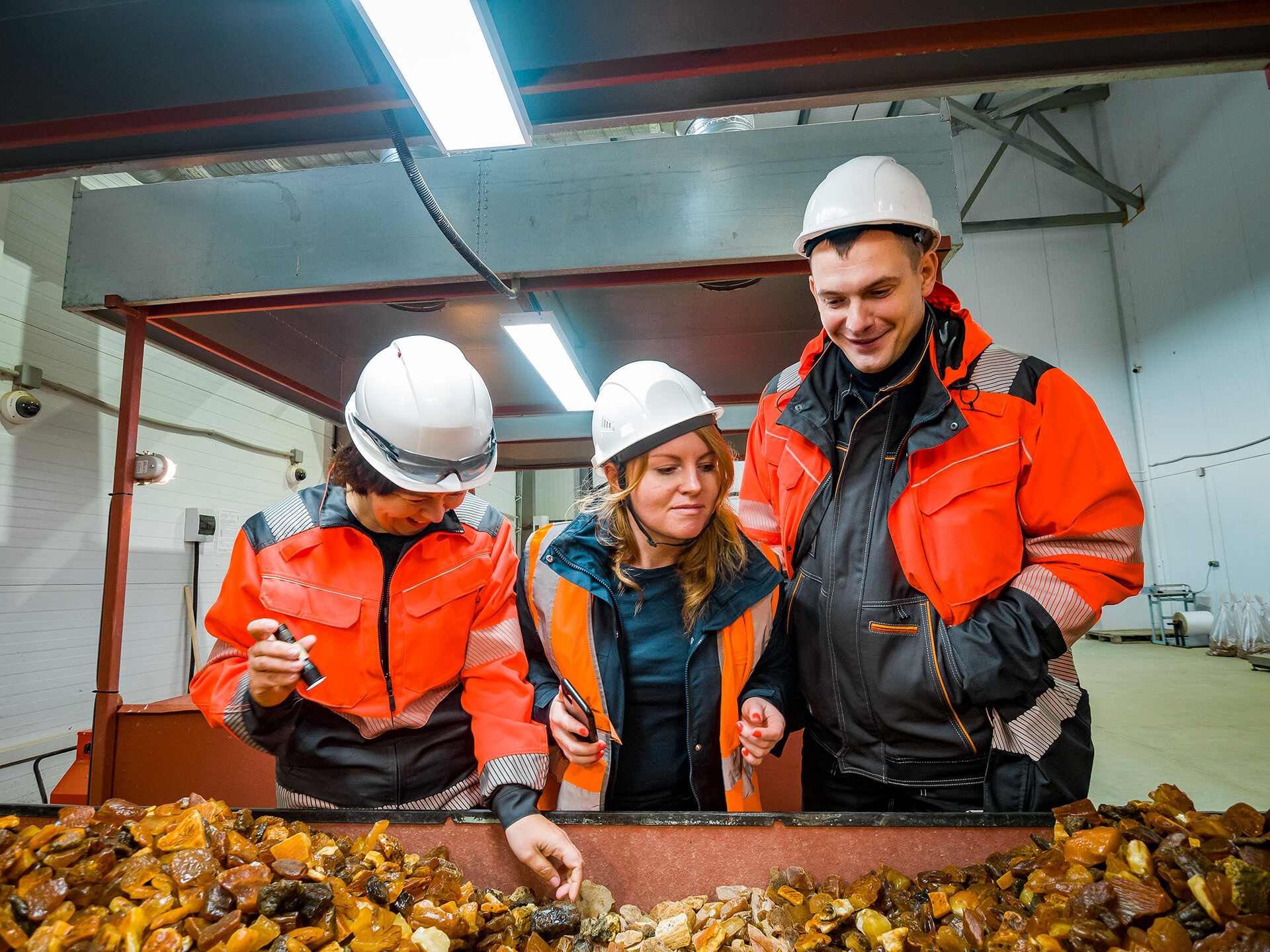
Alexey Korkin and Anna Dugina show a large amber extracted that day in the quarry.
Pavel Kuzmichev“Any rock is heavier than amber,” Alexey says. “There’s the simplest method to tell that it’s amber in front of you and not something else. You need to take a glass of water, pour a fair amount of salt in it, mix, and put in stones. Everything that sinks is not amber.” The thing is, amber’s density is almost equal to the density of water from the Baltic Sea; if you salt regular water, its density will rise and amber will float.

Everywhere in the factory there are grates that can "catch" even the smallest amber.
Pavel KuzmichevThe initial sorting at the plant is conducted precisely so; all pulp comes to a separator and bathes in tubs with a salt solution.

Amber baths.
Pavel KuzmichevThen, all stones are sorted by size: small ones are immediately packaged in sacks, while large ones are sorted by hand, since there are sometimes unique specimens among them!

Anna Dugina, an expert gemologist of the combine, can spot special stones among thousands of others. “Royal white amber is the most expensive and rare. It only accounts for 1% of amber in nature! Landscape amber is also very highly prized, white with yellow streaks.”
There’s also “black lacquer” that, in the past, was considered the lowest kind; however, today, there’s a process for “making it pretty” and it’s now also highly sought after.

Anna Dugina shows interesting inclusions in large amber.
Pavel KuzmichevApart from interesting colors, there are sometimes inclusions in amber (in 6-8% of it), such as flora and fauna preserved in resin. “For example, we have a pretty dragonfly in amber, you can see it in the museum at the combine,” Anna says. Usually, nothing is done to stones like that, they’re simply impeccably polished. Transparent honey-colored amber is a ‘Baltic classic’, as the gemologist calls it. This is the stone we see most often at stores.
“After sorting, our specialists determine what’s to be sold at auctions (the combine has no direct contracts) and what will go to jewelry production,” Anna explains.

The amber is first spread out by size.
Pavel KuzmichevBoth Russian and foreign producers are among the combine’s clients. The Baltic stone is especially prized in China and in Arabic countries.

This amber is now ready to be delivered to the warehouse.
Pavel KuzmichevThe combine sells not just raw extracted amber, but also jewelry made from it. It’s also produced right in the village of Yantarny.


One of the walls of the workshop is decorated with a giant spider, “weaving” an amber net over the map of the world. “Back in 1954, Soviet jewelers came up with a spider design for a brooch that is still a symbol of the amber combine,” Vadim Parkhomenko told us, the head of the experimental production department. In total, they produce thousands of items of all kinds, coming up with new ones several times a week.
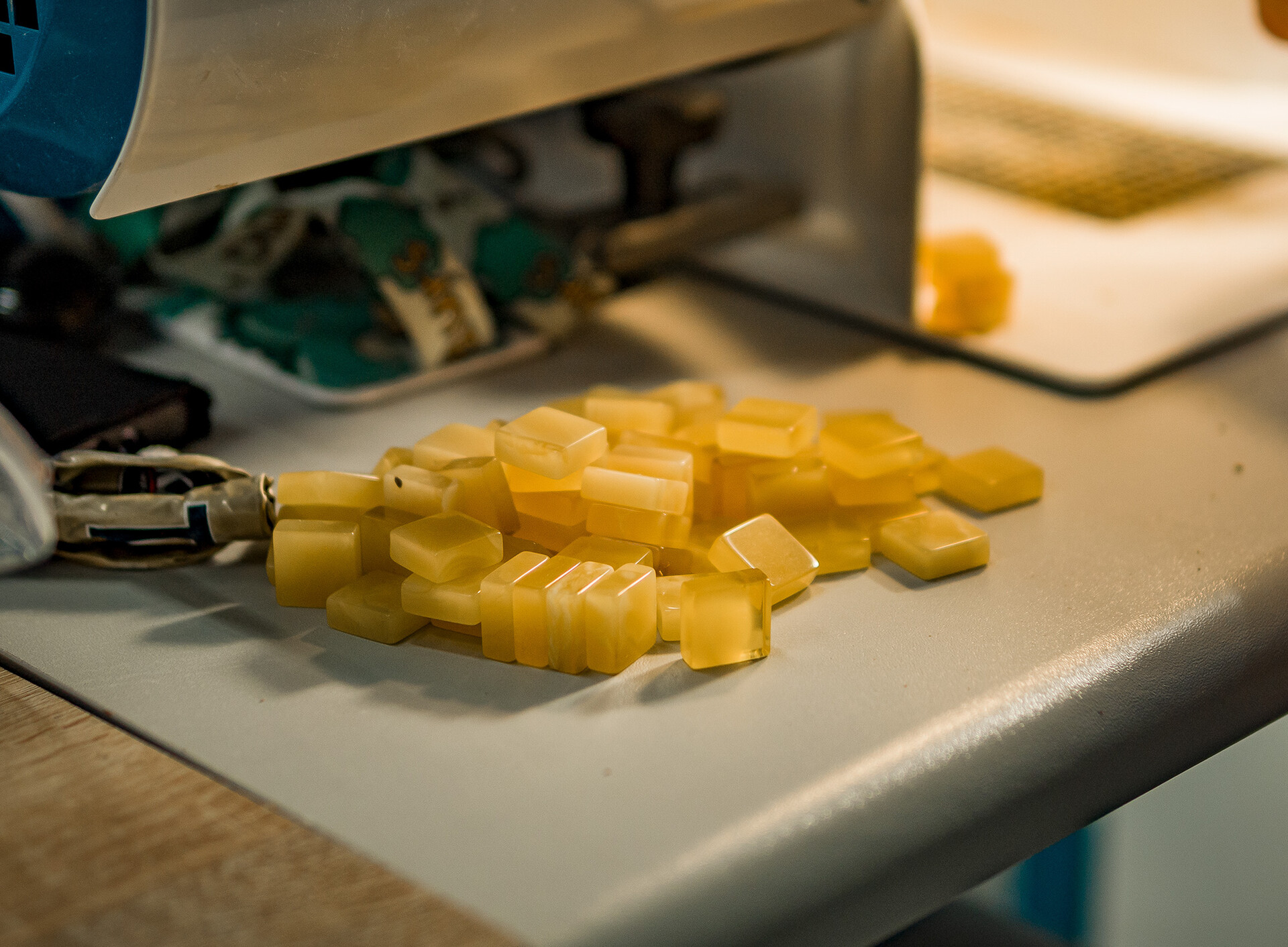
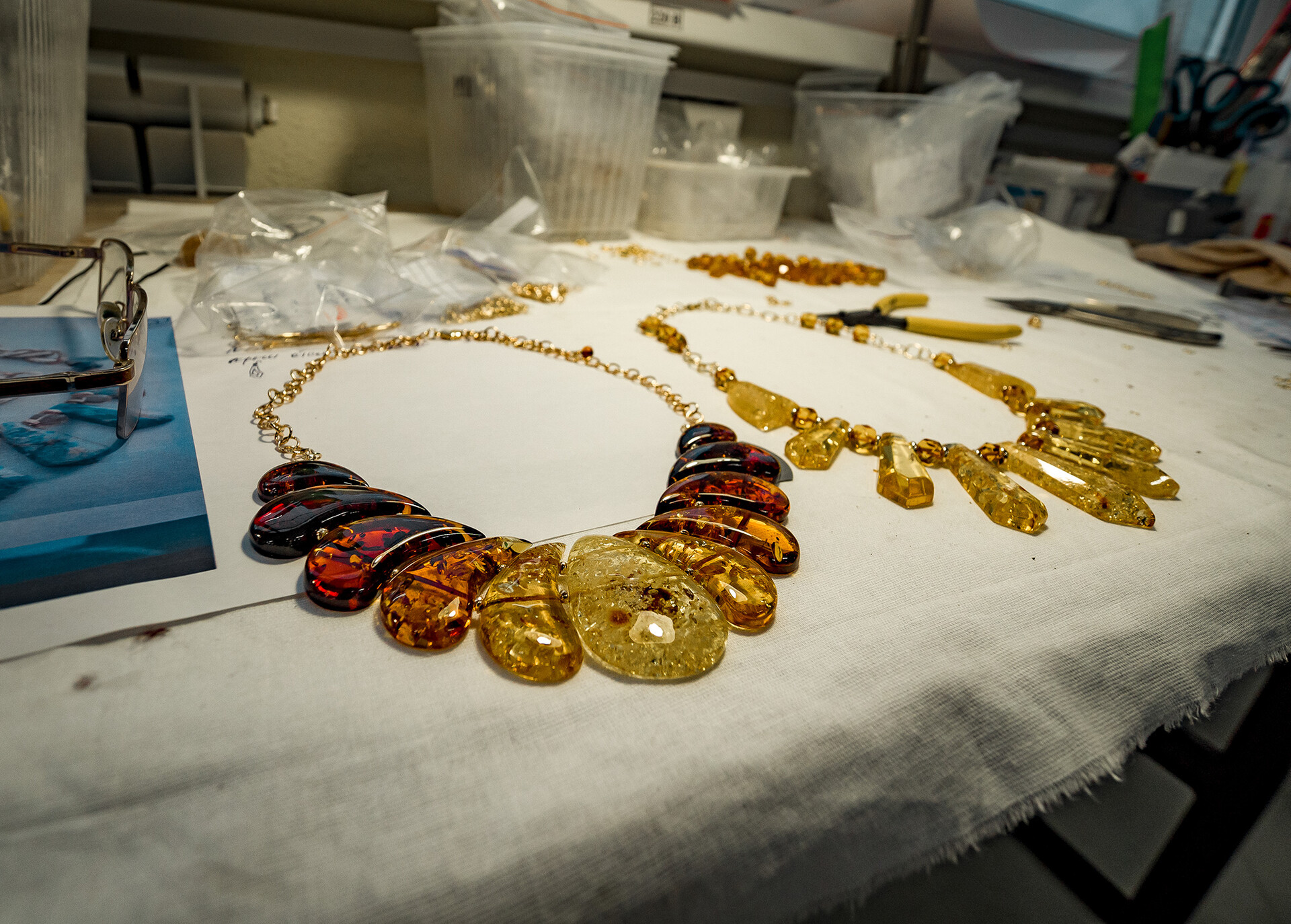
Artists think over the design, often suggestions come both from craftsmen and from clients. Some craftsmen prepare the stones of proper colors and sizes, others assemble the jewelry and others still check the prepared jewelry, holding it to the light – to check that there’s no cracks or scratches.

They try not to dispose of anything: “scraps” of amber are used for art pieces, go under a press or are used for small details.


Many people learn right on the job. “You can acquire all the necessary skills during the work process, but then it depends on each person,” Vadim says. “Of course, it’s great to have a gemologist education, but you also need to be a bit of an artist.”
Stone carver Margarita Bulygina makes animal and human amber figurines. There are no two identical amber stones in nature, so each of her souvenirs is unique.

Margarita Bulygina.
Pavel Kuzmichev“Sometimes, we decide how to use the material based on the material itself, we study its color, its shape. Sometimes, we work with picking material for particular goals,’ Margarita explains. ‘You need to possess great spatial thinking, imagine in advance what you want to embody in the physical material, you need to have a 3D-computer inside of your head. My tool is the continuation of my hand.”

Margarita is a versatile artist by education, which means she has the skills of working with graphics, with drawing and with wood; she started here from ground zero and immediately understood the properties of amber. “If the stone is pliable, you can make a little figurine in just a day,” she says. “You only need to reason with the stone.”
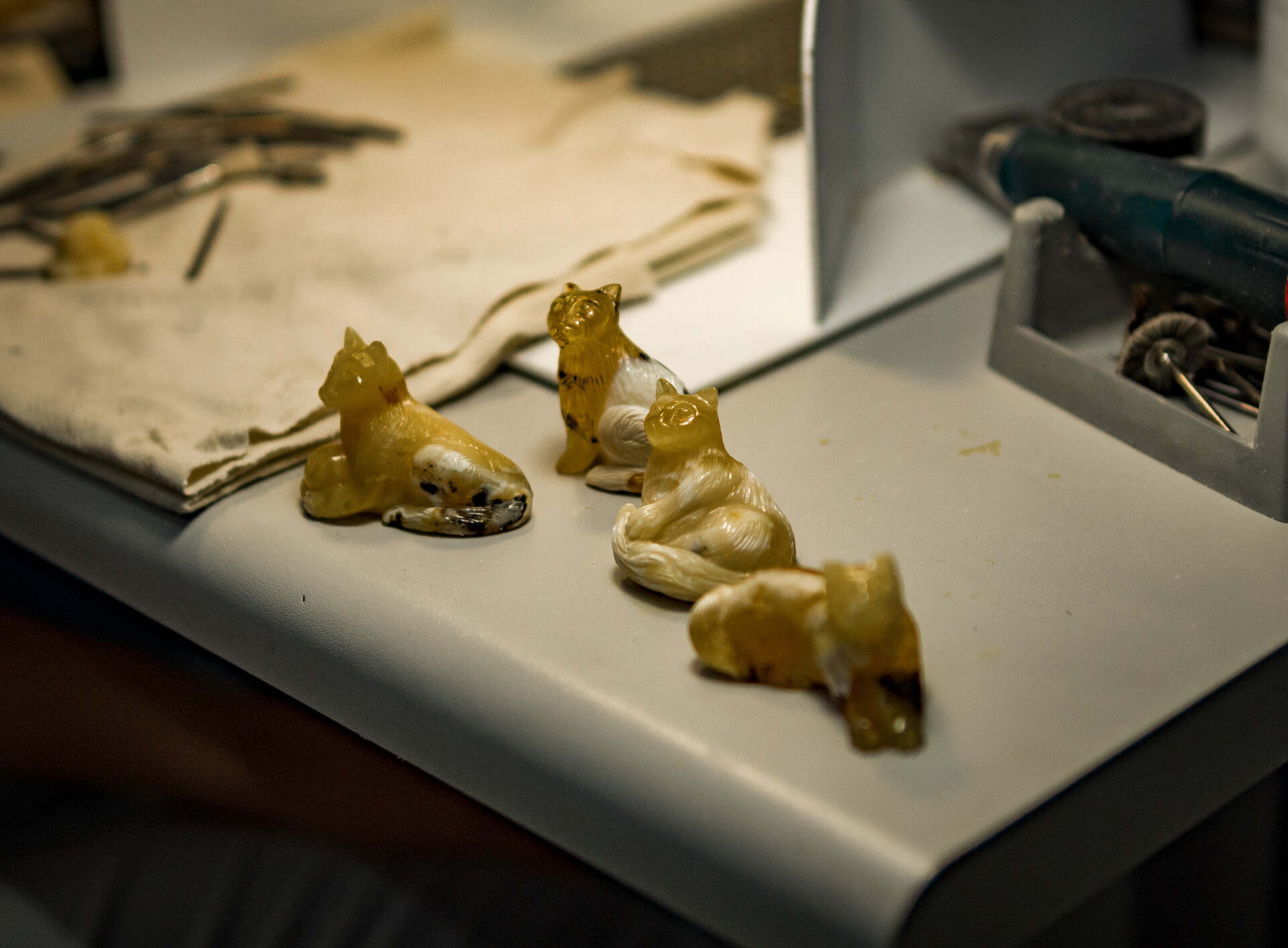
Dear readers,
Our website and social media accounts are under threat of being restricted or banned, due to the current circumstances. So, to keep up with our latest content, simply do the following:
If using any of Russia Beyond's content, partly or in full, always provide an active hyperlink to the original material.
Subscribe
to our newsletter!
Get the week's best stories straight to your inbox